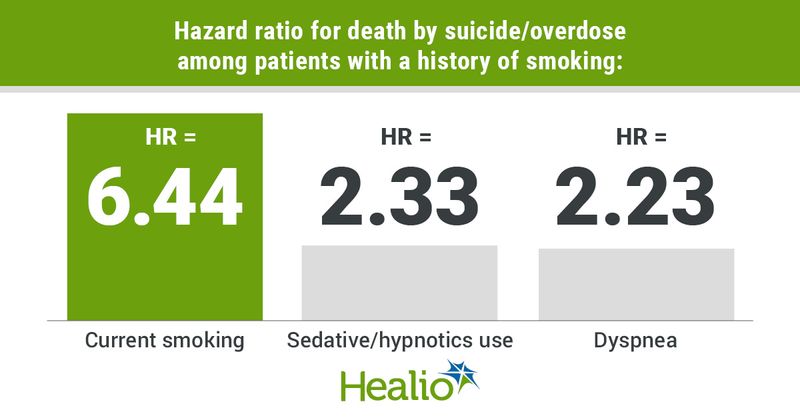Current smoking strong predictor of suicide, overdose among those with smoking history
Current smoking, use of sedative hypnotics and dyspnea increased the risk for death by suicide or drug overdose among adults with a smoking history with or without COPD, according to study results published in CHEST.
Further, risk for suicide in this patient population was not linked to airflow limitation, measured as FEV1 percent predicted, or other measures of COPD severity, according to researchers.


“An important aspect of our findings was that the objective measures of COPD severity (eg, airflow limitation from spirometry) that we examined were not associated with suicide/overdose, although symptom severity, specifically dyspnea, was,” Karin F. Hoth, PhD, associate professor of psychiatry at the University of Iowa, told Healio. “This finding suggests that the subjective experience of COPD is important in assessing suicide risk among individuals with smoking exposure. Further research is required to examine how COPD and current smoking interact on suicide risk and whether there is evidence of synergy between these two converging risk factors.”
In a prospective cohort study, Hoth and colleagues analyzed 9,930 adults (mean age, 59.6 ± 9 years; 53.4% men; 67.3% non-Hispanic white; 52.6% current smokers; mean BMI, 28.8 ± 6.3 kg/m2) with a 10-pack-year smoking history from the COPDGene Study to determine the factors that can predict suicide or drug overdose mortality in this patient population.
To evaluate time to suicide/overdose, researchers used Cox regression models that accounted for several time-varying independent variables in the past year: age, sex, race, BMI, pack-years, current smoking status, airflow limitation, dyspnea (modified Medical Research Council Dyspnea Scale score 2), 6-minute walk distance, supplemental oxygen use and severe exacerbations.
Results
Of the cohort, 12.4% of adults had preserved ratio impaired spirometry, 26.8% had mild to moderate COPD (Global Initiative for Chronic Obstructive Lung Disease [GOLD] 1-2), 17.6% had severe to very severe COPD (GOLD 3-4) and 42.5% had normal spirometry.
Additionally, 18.9% of adults used antidepressants, 10.1% used sedative/hypnotics, 3.5% used antipsychotics, 2% used mood stabilizers and 0.5% used stimulants. Fourteen percent of those with GOLD stage 3-4 COPD used sedative/hypnotics, which was the largest recorded use across groups.
Of the total cohort, seven adults died by suicide and 56 died by overdose for a total of 63 deaths during a median follow-up of 7.8 years.
Univariable models adjusted for age and sex demonstrated that race, BMI, current smoking status, use of sedative/hypnotics and dyspnea all significantly were linked to death of suicide or overdose.
In a multivariable model adjusted for univariable significant factors, age and sex, researchers observed several risk factors related to suicide/overdose mortality including a 6.44-fold (95% CI, 2.64-15.67) increased risk with current smoking, a 2.33-fold (95% CI, 1.24-4.38) increased risk with use of sedative/hypnotics and a 2.23-fold (95% CI, 1.34-3.7) increased risk with dyspnea.
Conversely, older age (HR per decade = 0.45; 95% CI, 0.31-0.67), higher BMI (HR = 0.95; 95% CI, 0.91-0.99) and African American race (HR = 0.41; 95% CI, 0.23-0.74) showed a decreased risk for suicide/overdose mortality in this model.
Mean FEV1 percent predicted was 76.1 ± 25.5 for the total cohort, but researchers noted this measure was not linked to risk for suicide.
Future studies, recommendations for clinicians
The results of this study underscore the importance of incorporating subjective measures of disease symptom severity when assessing suicide/overdose risk among individuals with smoking exposure and COPD, according to Hoth.
“Future studies can be improved by gathering more information about comorbid mental health conditions at baseline so that the impact of depression and anxiety can be included in modeling predicting suicide/overdose,” she said.
Based on the study’s results, clinicians should check adults with a smoking history and heavy symptom burden for depression, anxiety and suicidal ideation, Hoth added.
“Some suggestions for the clinician who is concerned about risk for suicide/overdose for one of their patients include:
- approach interactions with patients with a calm, open, curious manner asking about quality of life and things that matter to the patient — a move toward whole-person care has a positive impact;
- familiarize themselves with determining level of suicide risk and tools available in their health care setting, with recommendations available in an article by Weber and colleagues in Medical Clinics of North America;
- contact family or friends with permission when needed for information and support;
- work with the patient or family to reduce access to lethal means (eg, firearms, excess medications); and
- facilitate mental health treatment when appropriate, emergently if necessary.”
This study by Hoth and colleagues emphasizes the importance of quitting smoking and implementation of a more specific suicide risk assessment for patients who have a history of smoking, according to an accompanying editorial by Natalie B. V. Riblet, MD, MPH, assistant professor of psychiatry at Dartmouth Institute, and Bradley V. Watts, MD, MPH, associate professor of psychiatry at Dartmouth Geisel School of Medicine.
“The results reiterate the critical need to promote smoking cessation as a strategy to reduce morbidity and death in the population,” Riblet and Watts wrote. “Patients who smoke heavily will also be helped by having access to mental health treatment. Patients with comorbid COPD and depression or anxiety, in particular, can benefit from pulmonary rehabilitation. Suicide risk assessment in this population may also be improved by incorporation into the clinical evaluation specific factors such as current smoking, use of sedatives, and the presence of dyspnea.”
For more information:
Karin F. Hoth, PhD, can be reached at karin-hoth@uiowa.edu.
References:
- Riblet NBV, et al. CHEST. 2022;doi:10.1016/j.chest.2022.10.016.
- Weber AN, et al. Med Clin North Am. 2017;doi:10.1016/j.mcna.2016.12.006.
